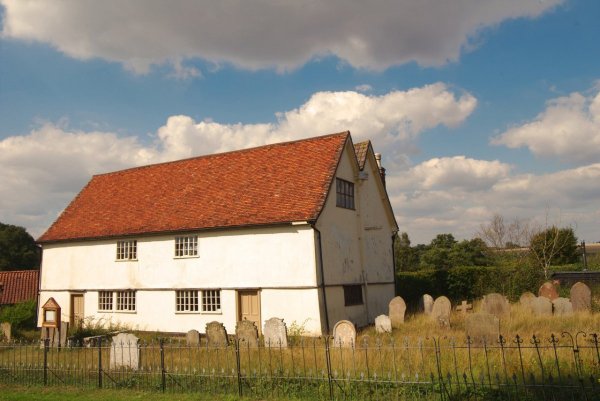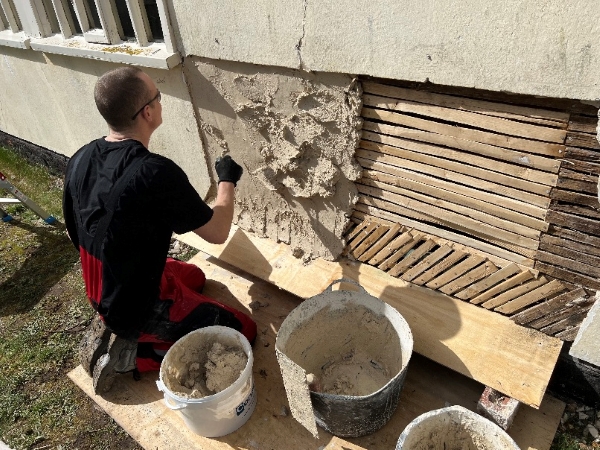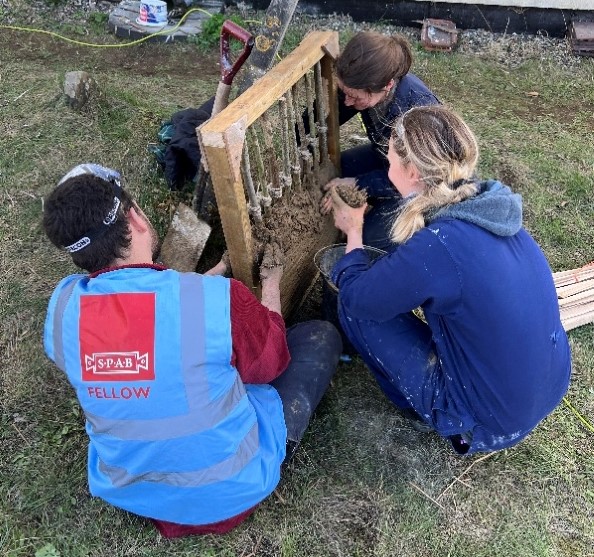Laura Brain, Architectural Assistant and 2023 SPAB Scholar, explores a lively debate sparked by a visit to Walpole Old Chapel in Suffolk.
We arrived in Walpole on a chilly March afternoon, fired up on chips from Southwold pier and keen to see what all the fuss was about. A scattering of gravestones and a scaffolding tower indicated that we had reached our destination, but the simple exterior of the building gave little indication of what awaited us inside.
Much like the first time meeting a new friend, the first impression of a special building is something that sticks. The Old Chapel's quiet charm revealed itself the moment that we crossed the threshold. And the more that we explored the building the more delights we uncovered. The telegraph pole propping the south-western gable; the beautifully crafted box pews with no discernible rhyme or reason to their numbering; the wave of the timber galleries and the camber of the brick floor, worn by hundreds of feet. Traces of past doors, windows and roofs long removed.
Personally, I love buildings for the stories that they tell, and Walpole's old chapel is a veritable book of fairytales. We spent hours trying to decipher the history of the chapel through its architecture - when and why this or that timber had been used, what came first, what was a repair and what was part of the building's agricultural provenance.

Credit: Friends of Walpole Old Chapel
As part of its conservation, areas of the chapel's fabric have been 'opened up', providing the unique opportunity to look behind its skin and start to uncover more of how it was built. Describing the building as 'timber framed' does little justice to the plethora of materials and techniques employed in the walls alone. Areas of lathe and plaster abut brick infill panels held together with clay mortars; reed panels and areas where lime renders were replaced with cement in the second half of the last century. Key finds included panels of ‘mud and stud’, a vernacular style of ‘wattle and daub’ using a clay and straw ‘daub’ reinforced with vertical hazel staves.
Over the course of the week we sampled a range of techniques under the guidance of local craftsperson and former SPAB Fellow Thom Taylor. The experiments were intended to help determine the best course of action for the ongoing repair and maintenance of the chapel.
Throughout its history the chapel has been constructed and repaired from the available materials, so in this tradition the materials we used were sourced as locally as possible; clay, sand and chalk; reed and horse hair; riven chestnut lathes. We tried different lime mixes on a variety of backgrounds (or 'substrates') including reed panels, mud and stud, and more common lathwork techniques.

Credit: Laura Brain
This moment in the history of the chapel provides an opportunity for the current generation of supporters to add something to the building's story. Whilst at Walpole we had lively debates about the works the chapel needs to make it useable for years to come. The conversation naturally focussed on the treatment of the walls, and whilst it is always a challenge to reach a consensus, and what emerged were two key schools of thought.
Many argued that the chapel should be lime plastered and limewashed to retain its current appearance. This option requires regular maintenance, and in the past buildings such as this would have likely have been cared for by local people. Ideally limewashing would be carried annually to ensure that the walls remain protected and fresh. Perhaps in the past this would have been a community activity, with supporters of the chapel coming together to carry out the relatively simple task, following the sun’s journey around the building and applying several coats of limewash over a course of a day. Is this a tradition that could be revived in Walpole?

Credit: Laura Brain.
If there is not the capacity within the chapel's funds and supporters to maintain the exterior of the building in this way, could a lower maintenance finish be considered? Many local buildings are at least partially weatherboarded, and this was proposed as a solution which would perhaps better safeguard the structure at a lower cost over a longer period. But would this be an acceptable change to those who have grown up with the building's rendered exterior?
In our role as conservation professionals, we can only contribute our knowledge and expertise to assist those responsible for the future of the chapel to make an informed decision. As it has been for all of its history, this chapel must continue to be shaped by the local people who use it and who will ultimately be responsible for its upkeep and its future. I have no doubt, from experiencing the care that the people of Walpole have for their chapel, that this much-loved building will continue to be nurtured and bring the community together for generations to come.
Written by Laura Brain, Architectural Assistant and 2023 SPAB Scholar. Find out more about Walpole Old Chapel and the SPAB Scholarship programme.
